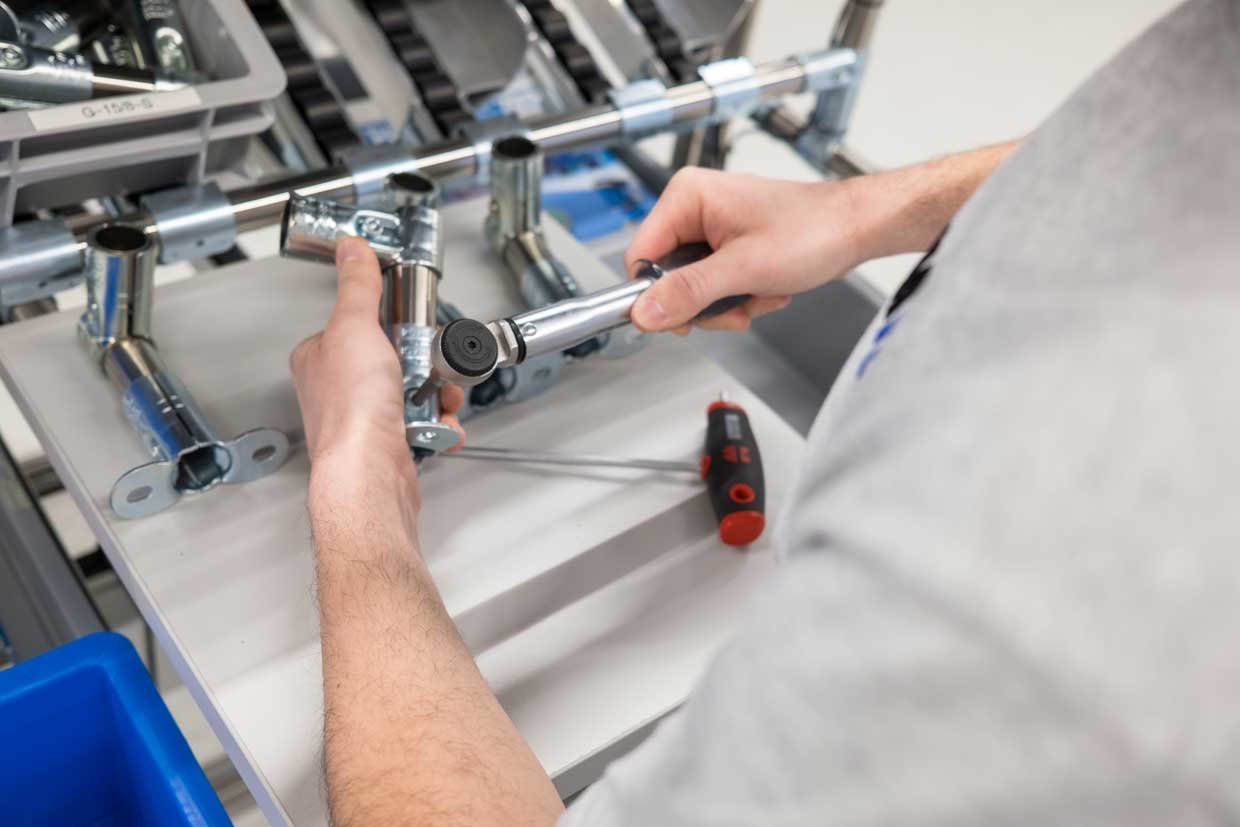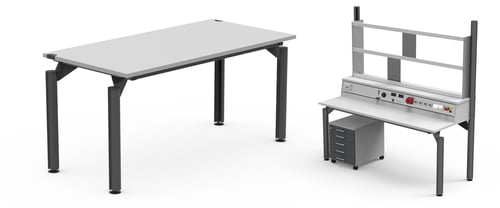5 min read
Just In Time (JIT): Definition, Advantages and Implementation
![]() Jens Walter
:
06.Februar.2025
Jens Walter
:
06.Februar.2025
In an era where efficiency and cost-effectiveness determine business success, the Just-in-Time (JIT) strategy has emerged as a cornerstone for supply chain and manufacturing excellence. Developed by Toyota in the 1950s, JIT has reshaped industries worldwide by promoting lean production, reducing waste, and improving operational responsiveness.
This blog article explores JIT principles, benefits, challenges, applications, and the technologies that increase efficiency and enhance its implementation.
What is Just In Time?
At its core, JIT is a production and inventory management approach where materials, components, and finished goods are delivered precisely when needed, rather than being stockpiled. This "right on time" strategy eliminates excess inventory, ensuring that resources are used efficiently and only what is required is produced.

Key Principles of just-in-time:
- Pull System: Demand drives jit production, meaning items are made to order rather than forecasted.
- Elimination of Waste: Focus on reducing excess inventory, defects, overproduction, and unnecessary processes.
- Continuous Improvement (Kaizen): Incremental improvements in processes to enhance quality and efficiency.
- Close Supplier Relationships: Strong collaboration ensures timely deliveries and high-quality inputs.
Advantages of Just In Time
Adopting JIT can bring transformative benefits to businesses. Below are the key advantages:

1. Reduced Inventory Costs
By minimizing the need to store raw materials or finished goods, JIT inventory management and JIT inventory systems significantly reduce inventory holding costs, such as warehousing, insurance, and depreciation. These systems streamline operations, ensuring resources are utilized efficiently while maintaining optimal supply levels and reducing waste with inventory management system and inventory control.
2. Minimized Waste
JIT aligns with lean manufacturing principles by reducing overproduction, scrap materials, and unused stock. This not only saves money but also supports sustainability efforts with just-in-time inventory.
3. Improved Product Quality
In just-in-time manufacturing with a focus on producing only what's necessary, businesses can invest more effort into ensuring each product meets high-quality standards, reducing defects and returns with production process for jit manufacturing production runs with lower quantity of inventory.
4. Enhanced Cash Flow
Reduced inventory levels free up working capital, storage costs, cut inventory costs, allowing businesses to reinvest in growth initiatives like R&D, marketing, or automation.
5. Faster Response to Market Changes
With no excess inventory to clear, businesses using JIT can adapt more rapidly to shifts in customer demand or emerging trends with less wasted time and lead time with management strategy.
6. Better Supplier Relationships
Frequent and smaller orders encourage collaboration between manufacturers and suppliers, fostering a partnership that focuses on mutual growth and reliability along with just-in-time delivery which gives orders on time.
Challenges in Implementing Just In Time
While JIT offers considerable benefits, its success depends on overcoming several challenges:
1. Dependency on Suppliers
A seamless supply chain is crucial for JIT. Any disruption, such as delayed shipments or quality issues, quality management can halt production and affect customer satisfaction for large inventory.
2. Lack of Inventory Buffer
Since JIT minimizes inventory, businesses have little room for error. Unforeseen demand spikes or delays can lead to stockouts and lost sales and decrease waste.
3. Implementation Complexity
Transitioning to a JIT system often requires significant investment in process redesign, training, and technology to ensure real-time visibility and coordination.
4. Risk of External Disruptions
Natural disasters, geopolitical issues, or pandemics can disrupt global supply chains, making JIT operations vulnerable without contingency planning.
5. Higher Transportation Costs
Frequent small shipments may increase logistics costs, particularly if suppliers are located far from production facilities.
Technologies that Enhance Just In Time
Modern advancements have made JIT more reliable and scalable. Here are some of the technologies that support its implementation that is needed for production:
1. Internet of Things (IoT)
IoT devices provide real-time data on inventory levels, production progress, and supply chain conditions. Sensors track stock usage and automatically reorder materials to ensure availability without overstocking.
2. Artificial Intelligence (AI)
AI-powered demand forecasting tools analyze historical and real-time data to predict market trends accurately. This helps businesses align production schedules with customer needs.
3. Robotics and Automation
Robots in manufacturing and warehouses optimize workflows by performing repetitive tasks with speed and precision. For example, mobile robots can transport goods efficiently within facilities.
4. Supply Chain Management Software
Integrated systems like ERP (Enterprise Resource Planning) and WMS (Warehouse Management Systems) streamline operations, providing a unified platform to manage suppliers, inventory, and logistics.
5. Lean Tools like Karakuri
Karakuri, a low-cost automation approach, uses mechanical systems to simplify material handling without relying on expensive electronic solutions. This aligns perfectly with JIT’s goal of reducing waste and optimizing resources.
Industries Leveraging Just In Time
1. Automotive
JIT originated in the automotive sector, with Toyota leading the way. Today, companies like Ford and BMW use JIT to align production with customer orders, reducing excess stock and ensuring faster delivery.
2. Retail
Retailers like Walmart and Zara employ JIT to maintain minimal inventory levels, restocking shelves just in time to meet customer demand. This strategy keeps costs low and ensures fresh products.
3. Electronics
Brands like Dell use JIT to build computers based on customer specifications, minimizing finished goods inventory and allowing for product customization.
4. Healthcare
Hospitals use JIT to manage critical supplies like medications, surgical instruments, and personal protective equipment, ensuring availability without overstocking or expiration risks.
Steps to Implement Just In Time Successfully
-
Analyze Current Processes Identify inefficiencies, bottlenecks, and waste in the existing production or supply chain.
-
Establish Reliable Supplier Relationships Partner with vendors who can deliver high-quality materials on time consistently.
-
Adopt Lean Practices Introduce lean principles like 5S, Kaizen, and value stream mapping to improve operational flow.
-
Invest in Technology Implement real-time tracking, demand forecasting, and automation to enhance visibility and responsiveness.
-
Train Employees Ensure staff at all levels understand JIT principles and are equipped to manage the transition.
-
Monitor and Optimize Continuously track performance metrics, identify areas for improvement, and adapt to changing conditions.
-1.png?width=1080&height=1080&name=Advantages%20of%20Just%20In%20Time%20(1)-1.png)
BeeWaTec and Just In Time: Driving Lean Efficiency
BeeWaTec empowers businesses to implement Just-in-Time (JIT) with innovative modular systems, low-cost automation, and mobile robotics. Our solutions optimize material handling, enhance productivity, and support lean operations.
- Streamlined Material Handling: Modular systems and conveyors reduce handling time and waste.
- Low-Cost Automation: Karakuri solutions offer affordable automation for repetitive tasks.
- Flexible Modular Systems: Adaptable designs meet fluctuating production demands.
- Mobile Robotics: AMRs like wheel.me ensure materials are delivered exactly where and when needed.
- Custom Workstations: Ergonomic setups maximize efficiency and minimize downtime.

With a focus on sustainability, expert support, and future-ready solutions, BeeWaTec is the perfect partner to help businesses achieve operational excellence to implement jit. Learn more at BeeWaTec.

FREE DOWNLAOD
Checklist to implement Just-in-time
The Ultimate Guide to Boosting Efficiency with Technology and Lean Practices. Download this handy JIT Optimization Guide.
Download for freeChecklist to implement Just-in-time
After you have filled out and sent the form, you will receive the checklist immediately by e-mail.
Conclusion
In today's competitive business landscape, the Just-in-Time (JIT) methodology, known as the Toyota Production System, stands as a vital tool for companies aiming to optimize their supply chains, reduce costs, and increase operational agility. By maintaining low inventory levels and focusing on receiving goods only when needed, JIT eliminates defective products and minimizes costs due to unsold inventory. While the transition to JIT may require overcoming challenges like supplier dependencies and the risk of external disruptions, such as disconnected production cycles, the integration of modern technologies like IoT, AI, and robotics can significantly enhance its effectiveness. By adopting JIT principles and leveraging solutions like BeeWaTec’s modular systems and low-cost automation, businesses can achieve smoother production flow, better management of human resources, functional production cells, and a more efficient production floor, leading to long-term success in supply chain operations.
Optimize Production and logistics with Just In Time (JIT)
With our modular system you can implement any solution you need. Discover your possibilities, existing solutions or build your own material flow system with Just In Time (JIT).




_Web_01_01.jpg?width=1240&name=Beewatec-3-(37)_Web_01_01.jpg)


